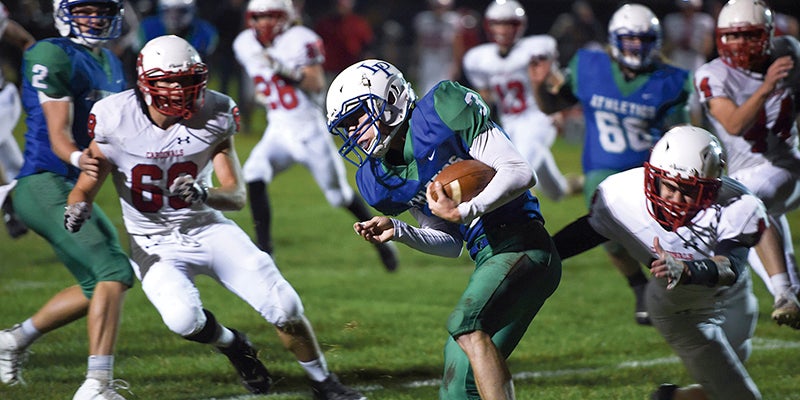Riege: Hot time summer in the city
Published 10:40 pm Wednesday, July 24, 2013
By Bob & Ginny Riege
Minnows are probably the most popular live bait. They are food for a wide variety of game fish, found in practically all freshwater habitats, and when hooked properly will swim energetically; all factors that make them good bait. Unfortunately, they are somewhat hard to keep.
There are dozens of ways to rig a minnow for fishing, but two are used most often. For trolling and casting, run the hook upward through both lips. Your bait will then move through the water in a natural manner.
When still fishing, run the hook through the back just in front of or behind the dorsal fin, being careful to miss the backbone. Hooked there, your minnow will remain lively for quite awhile.
Any angler, who fishes with minnows, knows the difficulty of keeping them alive. The key is to provide them with cool, uncrowned, well-aerated water. There are many devices which are marketed to do just that, but most are somewhat expensive. You may accomplish this yourself in a number of ways.
Tournament angler Ross Grothe uses the Beckman Cylinder Bait Container. Its design allows for consistent circulation of water to keep your bait active and fresh. The new Aqua-Flex Mesh™ allows water to flow through the bag keeping bait the same temperature as the water. Designed with a revolutionary float/weight system, this mesh bait bag floats on top of the water offering easy access to your bait; and yet it expands quickly and avoids “crowding” bait like other mesh containers. It stores easily in a live well, cooler or over the side of a boat or dock.
Not only in tournament angling, but also on canoe trips and wadding for walleyes in the shallows, Ross uses the Beckman Cylinder Bait Container and the Leech Saddle Bags.
“Have you ever noticed that shore anglers cast their bait as far out into the lake or river as possible, while people fishing from a boat are dropping their lures right next to shore?” “In the summer, much of the time, you’ll have more action if you keep your bait tight to the shore,” Grothe said.
“Don’t get me wrong, there are some instances when the best spot will be mid-river or lake, but there are plenty of times in the summer when the best action will occur close to shore,” according to Ross.
Ross went on to explain, “when fishing these shallow areas, it’s important that you keep motions to a minimum. Fish in shallow water are generally spookier than they would be in deep water. Walk softly and wear light colored clothing. You want a jacket or a sweatshirt that blends in with the sky. Remember that you’ll be above the fish and the sky will be the background. Dark clothing will stand out against the light background and the fish will easily detect your movements.”
Also, don’t forget to bring along a good pair of hip boots or waders. The air temperature might be warm and sunny, but the water is still very cold and you will have a short fishing trip if you get soaked.
The shallower the water, the more wary fish seem to be. In a deep river the anger’s approach does not have to be quite as stealthy as in a shallower one.
Fish at rest always face into the flow of water; this is the case in rivers, streams or wind blow lakes and reservoirs. They have a small blind spot behind them, making it advantageous for fisherman to work in from behind them. Also, any silt or sand dislodged while wading will be carried downstream and not over the fish. For these reasons, downstream wadding is more difficult to accomplish successfully without alerting the fish.
Clumsy and careless wading is a primary cause of not catching stream fish. Each foot must be placed down as quietly as possible since the ripples and shock waves emanate outward as the angler wades. To prevent this, movements must be extremely slow.
Fish in a stream generally stay out of the main current, but close enough to grab a passing morsel. If one fish is caught in a particular spot, there is a good chance that another will take its place. With experience, an angler can learn to read the water surface and to know what is underneath. Slick places indicate a rock below the surface: the outside bend of moving water will be deeper than the inside of the bend; and rocks, trees and other structure that break the flow should all hold fish.
When working shallow areas to shore, especially when the water is clear, keep your cast parallel to the shore. The most active fish will be within 10 feet of shore, perhaps closer. If you cast the bait 30 feet out from the shore and retrieve it, the lure is in the most productive zone for only the last 10 feet of the cast. If you cast the bait parallel to the shore and retrieve it, it’s in the fish zone all the time. This technique is very productive even later on in the summer when fishing for walleyes.
As predator fish begin their post-spawn feeding habits, their focus centers on large forage. Young of the year Perch, Cisco, River Shiners and Chubs, along with other forage, such as frogs, crawfish and even their own offspring will be targeted. Successful trophy hunters will match the hatch, almost scientifically, at this time of year. Imitation of the forage base is very critical and a key to productivity during the summer feeding binge!
Feeding forays are anything but mysterious! The fish have to eat a lot as summer activity increases. The perdition cycle is in high gear on reefs, large points and adjacent flats, and in neck down flowage areas. Veteran anglers can predict these movements, and position themselves for hot summer action on the biggest fish of the year.
Walleyes will be along the riprap banks and rocky shorelines in the summer because they slide in behind the rocks and riprap to avoid current conditions and as a staging place for ambushing their next meal. In dirty or stained water it’s possible to dabble a jig tipped with a minnow on a long rod. Just lift and drop the jig around rocks and anything else that breaks the current, according to Grothe.
“When I am wadding for walleyes in the shallows it is essential to use the live bait approach. The Beckman Cylinder Bait Container is ideal for wadding. It is like having a minnow bucket only without the weight or bulk, plus the minnows swim freely and allow the “river to run through them.”
When the weather heats up and you want to keep your bait alive longer remember to use the Beckman Cylinder Bait Container and you will have increased your chances of success while on the water this summer.




